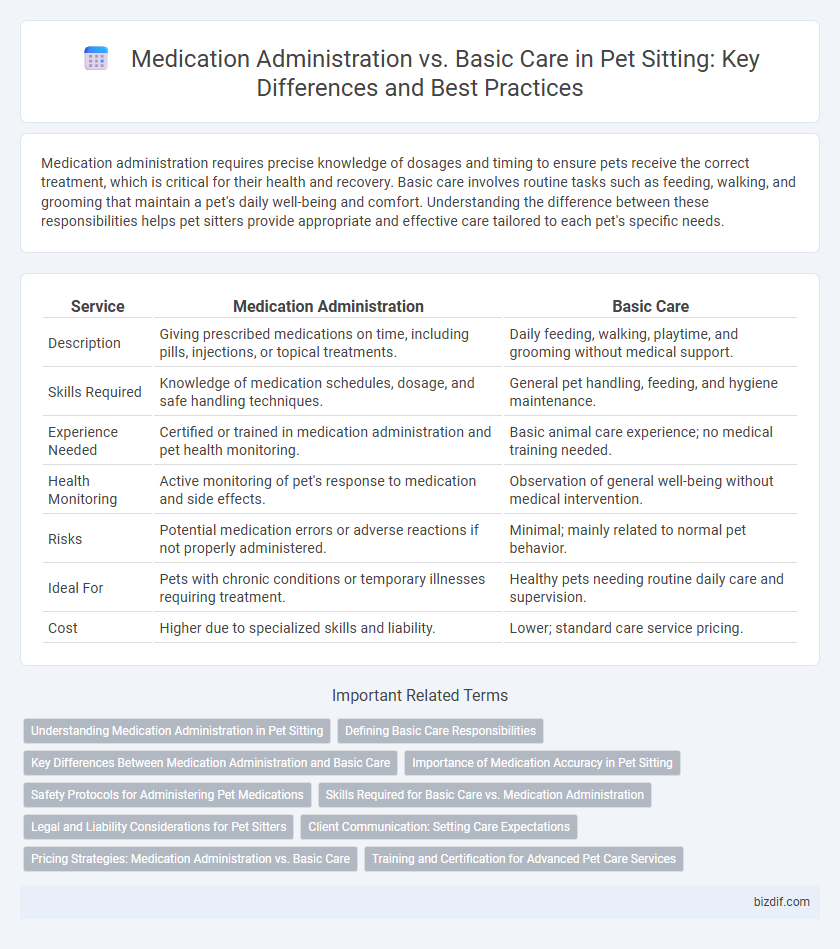Medication administration requires precise knowledge of dosages and timing to ensure pets receive the correct treatment, which is critical for their health and recovery. Basic care involves routine tasks such as feeding, walking, and grooming that maintain a pet's daily well-being and comfort. Understanding the difference between these responsibilities helps pet sitters provide appropriate and effective care tailored to each pet's specific needs.
Table of Comparison
| Service | Medication Administration | Basic Care |
|---|---|---|
| Description | Giving prescribed medications on time, including pills, injections, or topical treatments. | Daily feeding, walking, playtime, and grooming without medical support. |
| Skills Required | Knowledge of medication schedules, dosage, and safe handling techniques. | General pet handling, feeding, and hygiene maintenance. |
| Experience Needed | Certified or trained in medication administration and pet health monitoring. | Basic animal care experience; no medical training needed. |
| Health Monitoring | Active monitoring of pet's response to medication and side effects. | Observation of general well-being without medical intervention. |
| Risks | Potential medication errors or adverse reactions if not properly administered. | Minimal; mainly related to normal pet behavior. |
| Ideal For | Pets with chronic conditions or temporary illnesses requiring treatment. | Healthy pets needing routine daily care and supervision. |
| Cost | Higher due to specialized skills and liability. | Lower; standard care service pricing. |
Understanding Medication Administration in Pet Sitting
Medication administration in pet sitting demands precise knowledge of dosage, timing, and specific delivery methods to ensure the pet's health and safety. Unlike basic care routines such as feeding and walking, administering medications requires understanding potential side effects and monitoring the pet's response for any adverse reactions. Specialized training in handling prescription drugs and clear communication with pet owners about medication schedules are critical components for effective pet sitting services.
Defining Basic Care Responsibilities
Basic care responsibilities in pet sitting include feeding, providing fresh water, exercise, and maintaining hygiene such as litter box cleaning or coat brushing. Medication administration involves precise delivery of prescribed treatments like pills, injections, or topical applications, requiring careful attention to dosage and timing. Understanding these distinctions ensures both everyday wellness and effective medical management for pets under sitter supervision.
Key Differences Between Medication Administration and Basic Care
Medication administration in pet sitting involves the precise delivery of prescribed drugs, requiring careful attention to dosage, timing, and potential side effects, while basic care focuses on routine tasks such as feeding, grooming, and exercise. Administering medication demands specialized knowledge and sometimes documentation, whereas basic care centers on maintaining general health and comfort. Key differences include the complexity, risk level, and training required for medication administration compared to the more straightforward responsibilities of basic care.
Importance of Medication Accuracy in Pet Sitting
Accurate medication administration in pet sitting is crucial to ensure pets receive the correct dosage and timing, preventing adverse reactions and promoting effective treatment. Unlike basic care tasks such as feeding and walking, medication management requires precise attention to veterinary instructions and potential side effects. Maintaining accuracy in medication helps safeguard pet health and supports recovery, highlighting the importance of specialized training for pet sitters.
Safety Protocols for Administering Pet Medications
Proper medication administration for pets requires strict adherence to safety protocols including accurate dosage calculations, confirmation of pet identification, and secure handling of pharmaceuticals to prevent contamination or accidental ingestion. Basic care focuses on routine tasks like feeding, grooming, and exercise, but medication administration demands enhanced vigilance, use of protective equipment, and clear documentation of each dose. Implementing standardized safety checklists and immediate reporting of adverse reactions are critical for safeguarding pet health during medication administration in pet sitting services.
Skills Required for Basic Care vs. Medication Administration
Basic care in pet sitting requires strong observation skills, ensuring pets are fed, exercised, and comforted according to their routines and preferences. Medication administration demands precise knowledge of dosages, timing, and methods such as oral, topical, or injectable delivery, alongside a clear understanding of potential side effects and emergency protocols. Mastery of medication administration calls for higher technical proficiency compared to the general attentiveness and routine management skills needed for basic care.
Legal and Liability Considerations for Pet Sitters
Pet sitters must understand the legal distinctions between medication administration and basic care, as administering medication often requires specific certifications or licenses depending on local regulations. Liability risks increase significantly when handling medications, making it essential for sitters to obtain explicit client consent and maintain detailed records of all treatments given. Neglecting proper protocols can result in legal consequences, emphasizing the importance of clear communication and adherence to pet care laws.
Client Communication: Setting Care Expectations
Effective client communication in pet sitting ensures clear articulation of medication administration protocols versus basic care tasks, preventing misunderstandings and promoting pet safety. Setting care expectations involves detailing dosage schedules, potential side effects, and emergency instructions alongside routine feeding, walking, and playtime activities. Transparent dialogue fosters trust and enables pet sitters to provide tailored care that meets each pet's specific health and wellness needs.
Pricing Strategies: Medication Administration vs. Basic Care
Pricing strategies for pet sitting services differ significantly between medication administration and basic care due to the complexity and responsibility involved. Medication administration demands higher fees reflecting specialized skills, potential health risks, and increased liability, often charging an additional $10 to $20 per visit. Basic care, including feeding, walking, and companionship, typically falls within a standard rate range of $15 to $30 per visit, emphasizing volume and routine comfort over technical expertise.
Training and Certification for Advanced Pet Care Services
Training and certification for advanced pet care services emphasize proper medication administration techniques beyond basic care routines like feeding and walking. Certified pet sitters undergo specialized courses in pharmacology, dosage calculation, and recognizing adverse reactions to ensure safe and effective treatment. This expertise distinguishes advanced caregivers, providing pet owners confidence in managing complex health needs.
Medication administration vs Basic care Infographic

 bizdif.com
bizdif.com